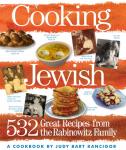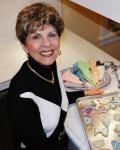
BUY COOKING JEWISH by clicking here now.
An Israeli mosaic
from The Orange County Register
September 14, 2001
by Judy Bart Kancigor
When Hana Lustigova Greenfield returned to her native Czechoslovakia in 1945 after liberation from Bergen-Belsen concentration camp, she miraculously found her sister, then her rabbi, who was preparing the synagogue for Rosh Hashanah (the Jewish New Year). He had the sisters cut an apple and dip the slices in honey, telling them, "As bitter as was our past life, we should have a sweet future."
Just one of hundreds of stories in "The Foods of Israel Today" (Knopf $40), the latest book by Joan Nathan, the award-winning author of "Jewish Cooking in America" and host of the PBS TV series of the same name. More than a cookbook, it is an exhaustively researched and compellingly told saga of a vibrant land and its diverse people, from its rich ancient history through its beleaguered present.
Nathan is a tireless investigator and a good listener. She entered the kitchens of both ordinary Israelis and popular restaurants, gathering stories to accompany the 300 recipes from Jews, Christians and Moslems.
"I couldn't write the book now," says Nathan. "It would be very difficult. I went to places I couldn't go to today. I visited towns that even my Israeli friends had never been to. Everywhere I went people couldn't have been nicer to me, but I don't know how they'd be now."
While working in the early '70's as a foreign press attaché for the mayor of Jerusalem, Teddy Kollek, she noticed how cooler heads prevailed when disputes were settled over a shared meal. "Food became a means of breaking down political and ethnic barriers," she notes.
Having grown up in Rhode Island in an Ashkenazic (Eastern European) home, Nathan quickly became intoxicated with the new flavors of Israel. "Rosh Hashanah had always meant chicken and matzo balls and apples dipped in honey. Then I went to Israel and it blew my mind. I remember going to a Yemenite home for Rosh Hashanah and thinking – where's the apples and honey? They had pomegranate. In Israel there are all these different taste sensations. That's what got me interested in writing about food."
Out of that experience came Nathan's first cookbook, "The Flavor of Jerusalem," with Judy Stacey Goldman, and now, six books and 25 years later, with "The Foods of Israel Today" she has come full circle.
It was the assassination of Prime Minister Itzhak Rabin in 1995 that inspired Nathan to memorialize the slain leader by capturing the "dynamic spirit of Israel...through the medium I knew best - food and culinary traditions. I wanted to show the richness of Israel's past and present through its many cuisines."
Note she says "many cuisines," not "Israeli cuisine," for is there an Israeli cuisine?
When David Ben-Gurion, Israel's first prime minister, declared the country's independence in May 1948, Nathan tells us, he envisioned the infant nation as a melting pot, which would generate a distinctive "Israeli food" as it would an "Israeli dance." While both hummus and hora typify Israel to many, neither the cuisine nor the choreography melt into a homogeneous identity in this land, roughly the size of New Jersey, teeming with 90 nationalities and diverse cultures and religions, and rather than a melting pot, Nathan describes the cuisine of Israel as a "multicultural mosaic."
"I don't think there will ever be a, quote, Israeli cuisine. There are certain foods which to me seem Israeli, Mediterranean ingredients, for example. Carrot salad is definitely an Israeli signature dish. If you go to a Sephardic restaurant, you'll have a Libyan this and a Moroccan that. Israelis are taking the best of immigrant foods and incorporating them."
Much has changed in Israel in the decades between her two books. "When I lived in Israel, you rarely went to restaurants except for falafel stands or cafes." Now this tiny nation, in which, says Nathan, more cookbooks are being written per capita than almost any other country, is competing internationally with its fois gras, olive oil, fine cheeses and wines.
"Today Israeli chefs are going to culinary schools around the world, coming back, and using local ingredients." And Nathan's enthusiasm for those ingredients is contagious. "I sprinkle za'atar (a spice combination of wild oregano, thyme, sumac and sesame seeds) on so many things. I love bulgur and frika, the parched wheat mentioned in the book of Ruth, chick peas, pomelos, and, oh, the figs in Israel are the best in the world. They're so fabulous, literally sun kissed."
The saga Nathan tells of the survival of Israel's native foods is almost as compelling as that of its people, from the seven original ingredients mentioned in Deuteronomy (barley, wheat, figs, dates, pomegranates, olives and grapes), to the harrowing tale of the introduction of 7,000 date saplings smuggled from Iraq, to the decimation by lice of the grape vines planted by Baron Edmond de Rothschild.
But it is the stories of ordinary people that are the real heart of the book. Like the Kurdish great-grandmother, married at 14, who makes 60 kubbeh (semolina and bulgur dumplings) for her family each week, sitting cross-legged on a blanket, her telephone at hand.
"I love seeing these very simple people taking pride in their cooking that a lot of us that are so sophisticated just don't have. For the holidays and Shabbat (the Sabbath) people aren't the way we are, all over the place. They're together as families."
It is the holidays, of course, when a family's most precious traditions are forged, and Rosh Hashanah, "the anniversary of the Creation" (beginning Monday evening), a solemn yet joyous holiday with its universal message of hope for a sweet new year, offers ample opportunity to pass along treasured traditions and create new ones. Such is the stuff of which memories are made.
As a child, Nathan knew it was Rosh Hashanah when the blue plums were in. "My mother would have me put the plums delicately into the cake, and that meant it was Rosh Hashanah. Maybe that's how I started thinking seasonally about food."
She describes the chicken chelou (rice) that Iranian Jews serve for the holiday with carrots, raisins, cinnamon and sugar. Libyan Jews eat seven different fruits and vegetables and seven varieties of jam as a symbol of hope for abundance in the coming year, and Jews of Eastern European descent eat dishes with carrots, apples, raisins and honey. No sour or bitter dishes appear on this table. The traditional challah (braided egg bread) is baked in a round loaf, symbolizing the cycle of life.
"A lot of people complain to me that they have to cook the same things every year," says Nathan, "but as a mother, I feel the role of a parent is to create traditions for your children, and that sameness does it."
RECIPES
Libyan Couscous With Chickpeas, Squash, Zucchini and Eggplant
Jaffa Orange-Ginger Chicken with Baharat

